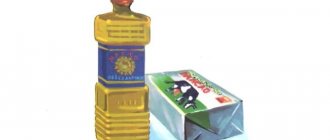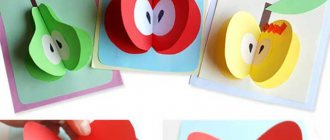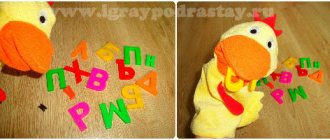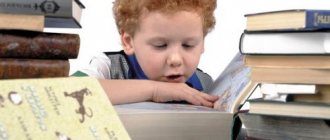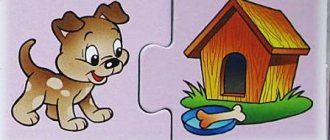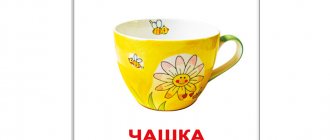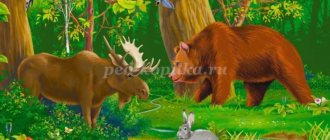The topic “Toys” must be used during speech therapy classes with preschoolers aged 2-7 years. Of course, the best pictures for children in kindergarten are Toys, which are specially selected for educational activities.
In the lexical material on this topic, several important “steps” can be identified, elements that must be mastered by preschoolers:
- The very generalizing concept of “toys”.
- Various names of items used for different types of games (story-based, action, etc.).
- General features and properties of toys, as well as their differences from other items.
- Ways to use certain toys.
- Features of their device.
- An idea of the material from which game items are made.
Here is a minimum list of words on the topic of toys for children that should be introduced into the active vocabulary of preschool children:
- Names of toys and their parts (nouns):
bear, bunny, dog, doll, car, ball, top, construction set, matryoshka, pyramid, head, torso, arm, leg, muzzle, paw, tail.
- Characteristics of items for games (adjectives):
* it is useful to teach them with children in pairs, comparing the properties of different toys.
Big - small, round - square, soft - hard, smooth - rough, fur - plastic, iron - wood, new - old.
- Various actions that can be performed with these objects (verbs):
Roll, carry, build, swing, dress, bathe, feed, wear, buy, lose, find, sew, play, collect.
Drawn pictures
Any product drawings are excellent material for:
- speech games;
- conversations;
- speech therapy exercises.
It is useful to use together both sets of subject cards with images of food and plot pictures of this topic.
Healthy and unhealthy food products are shown separately in pictures for children; it is important to teach children to easily distinguish between them.
Cards with drawn pictures are suitable for:
- classes;
- games;
- exercises.
Oil
Cheese
Dairy
Meat
Sausages
Canned food
Bread
Cereals, pasta
Cookies, bagels, crackers
Doman cards
Use Doman's cards in speech development classes on the topic Products. Bright, clear images with text can be used in games and exercises.
You can also use photos of food. It is important to choose those that have a neutral background, preferably a light one. Of course, photographs should be printed in advance and pasted onto cardboard.
Toys pictures for children
A cheerful drum, a bright pyramid, a magic carriage, a terrifying dinosaur, a fast train, a teddy bear and many others await you! Toys are needed not only to occupy free time. Properly selected gaming material can become a means of successful development of a child, developing important social and behavioral skills,
development of speech, motor and physical activity. Using children's close familiarity with toys, you can conduct various educational and developmental activities on this topic.
studying toys
For example, you can organize a simple speech development lesson on the topic “Toys”. To do this, you will need pictures depicting the most frequently encountered objects in gaming activities, and, if possible, the objects themselves. If a lesson is being held in kindergarten, as a rule, assembling toys is not difficult.
First, we try to remember all the familiar toys. Pictures for children, drawn in the most realistic way, will help with this. When listing objects, we name the actions that can be performed with them.
Drum
Pyramid
Yula
Duckling
Soldier
Robot
Fire truck
Paravozik
Puzzles
Tumbler
Ball
bear
Typewriter
Rocking horse
horse
Dollhouse
Doll
Cubes
Xylophone
Ship
Constructor
Doll carriage
Giraffe gurney
Coach
Pencils
Dinosaur
Harmonic
Helicopter
Bike
Bucket and shovel
According to the above steps, we form several main groups of toys:
- construction - something from which you can build, design, create new objects;
- musical - those with the help of which we obtain various sounds;
- for role-playing games - those that have their own role in the game (animals, dolls, soldiers, as well as various pieces of doll furniture, houses, etc.);
- sports – ball, tennis rackets, bicycle, scooter, etc.;
- transport - cars, trains, etc.
Children's thinking differs from that of adults, so when distributing objects into groups, children sometimes offer the most non-standard solutions.
Then you can move on to a detailed description of the toys. Usually children are happy to join in this process if they have to describe their favorite toy. To make the task easier, we leave a simple plan:
- describe the appearance;
- what can you do with this toy;
- why does the child like her?
After such work, you can move on to an interesting game: one child must describe the toy without saying its name. The rest of the kids guess what they were talking about. With younger children, you can change the rules a little: the adult describes, and the children guess. Whoever guesses correctly receives a card with a picture of this item, then the result is summed up - who has more cards.
You can ask a few simple riddles:
Very similar to you:
You have arms, legs - she has them too;
You have eyes - she has eyes;
Do you need any more tips? (doll)
If there’s a whole bunch of us, we’ll build up a whole yard. (cubes)
I am always ready to take off at a gallop - after all, that’s what children need... (ball)
Only a daredevil can assemble me by gathering all my rings onto a rod. (pyramid)
For me, falling is not a problem.
I will always rise with a smile. (tumbler)
In conclusion, we move on to the artistic part: we try to draw the toy that we liked or remembered best. Before drawing, we once again remember all the toys; Pictures for children will help with this.
We make sure to make an exhibition out of the drawings so that each child feels the significance of their work.
Watch the video on the topic “Exploring toys”:
Story pictures
Use story pictures to compose stories with children in the classroom. For these purposes, plot paintings on the themes: “Grocery supermarket”, “At the vegetable market”, “First cucumber”, “Cooking with mom”, “How the orchard feeds us in winter” are suitable.
Coloring pages
Speech therapists and teachers always use thematic coloring books to develop a child’s speech. Regular coloring not only helps children enrich their vocabulary and learn new grammatical structures, but also helps train fine motor skills, which, in turn, greatly helps activate the speech centers of the child’s brain.
Use pictures of Unhealthy Foods for children to color, this will not only improve speech skills, but also form an understanding of the basics of healthy eating and reasonable dietary restrictions. After coloring, you can have a conversation on the topic “The benefits and harms of the foods we eat.” It is easy to make a small presentation or collage from children's drawings, which can serve as additional visual material.
Creative works of children on lexical topics (middle group). Photo report
Maria Vasilika
Creative works of children on lexical topics (middle group). Photo report
THEME BERRIES
Bas-relief sculpture “Rowan branch”
Purpose: To guide children in the process of modeling to the image of real objects (rowan berries); strengthen children’s ability to roll plasticine between their palms in a circular motion; work in a team. Develop fine motor skills and aesthetic perception. Cultivate an interest in modeling.
THEME INSECTS
Application of autumn leaves “Butterfly”
Goal: To develop children’s ability to stick dried leaves, creating the silhouette of a butterfly from them. Train children's ability to use a brush, glue, oilcloth and rag. Exercise children in differentiating objects by shape. Develop fine motor skills and aesthetic perception. Cultivate accuracy, perseverance, and the desire to finish what you start.
VEGETABLES THEME
Origami "Turnip"
Goal: To develop children’s ability to fold a sheet diagonally and fold corners. Develop fine motor skills. Cultivate perseverance and the desire to finish what you start.
THEME FRUIT.
Applique and bas-relief modeling "Apple tree"
Goal: To train children to pinch off small pieces of plasticine and roll small balls using circular movements of their fingers. Strengthen the ability to convey the image of a fruit tree through plasticine printing. Strengthen the ability to flatten balls over the entire surface of the silhouette (tree crown). Develop imaginative perception. Cultivate interest in classes.
Application “What autumn brought us”
Goal: To train children’s ability to glue ready-made forms, use a brush, glue, oilcloth and a rag. Strengthen the ability to distinguish and name colors. Strengthen children's knowledge about vegetables and fruits. Develop creative thinking and imagination. Cultivate accuracy, perseverance, and the desire to finish what you start.
AUTUMN THEME
Applique Autumn trees
Goal: To train children’s ability to glue ready-made forms, use a brush, glue, oilcloth and a rag. Exercise children in differentiating objects by shape. Induce in children a desire to convey the beauty of autumn nature. Develop fine motor skills and aesthetic perception. Cultivate accuracy, perseverance, and the desire to finish what you start.
SPRING THEME.
Bas-relief sculpture “Villow”
Goal: To develop children’s ability to create willow buds using the bas-relief sculpting technique, to apply notches in a stack to give expressiveness to the work; consolidate the techniques of pinching and circular rolling. Develop fine motor skills. To foster an interest in nature in children.
THEME AQUARIUM FISH
Bas-relief sculpture “Aquarium”
Goal: To intensify the use of various sculpting techniques to create beautiful aquatic plants and decorative fish. Continue mastering relief modeling: create flattened fish figures, attach to the base, decorate with moldings. Improve the ability to design crafts with dots, spots, arcs, stripes. Develop combinatorial abilities. Cultivate neatness and a humane attitude towards fish.
Origami "Fish"
Goal: To develop children’s ability to fold a sheet of paper diagonally, work carefully with glue, and complete a craft. Develop fine motor skills. Cultivate perseverance and the desire to finish what you start.
THEME PETS
Construction from kinder capsules “Kitty”
Goal: To develop the ability to construct a cat from waste material, to play with the construction. Develop creativity, motor skills, visual attention. Foster a humane attitude towards pets
Modeling "Piglet"
Goal: To strengthen in children the ability to narrow the field of searching for an object. Introduce children to the technique of smearing plasticine, see the similarities and differences between objects. To help children develop skills in sculpting an animal, conveying the oval shape of the body, correlating body parts by size, and reinforcing the techniques of pulling and pinching. Develop coordination of small movements of the fingers. Foster independence and humane treatment of pets
THEME WILD ANIMALS
Application made from cotton pads “Bunny”
Goal: To train children in the ability to make applique from cotton pads. Continue to develop the ability to use glue. Develop the ability to finish drawing a finished applique. Cultivate neatness.
TOPIC CITY
Paper construction "House"
Goal: To develop children’s ability to fold a sheet of paper in half. Strengthen the ability to carefully work with glue. Develop fine motor skills. Cultivate perseverance and the desire to finish what you start.
THEME VICTORY DAY
Bas-relief sculpture “Eternal Flame.
Goal: To train children to pinch off small pieces of plasticine and roll small balls using circular movements of their fingers. To consolidate the ability to convey the image of the eternal flame through plasticineography. Develop imaginative perception. Foster respect for WWII veterans.
THEME INSECTS
Application “Ladybug, fly to the sky”
Goal: To train children’s ability to cut the corners of a square, rounding them, to arrange the details of the image based on the sample. Continue to develop the ability to work with scissors correctly. Develop fine motor skills. Foster independence.
